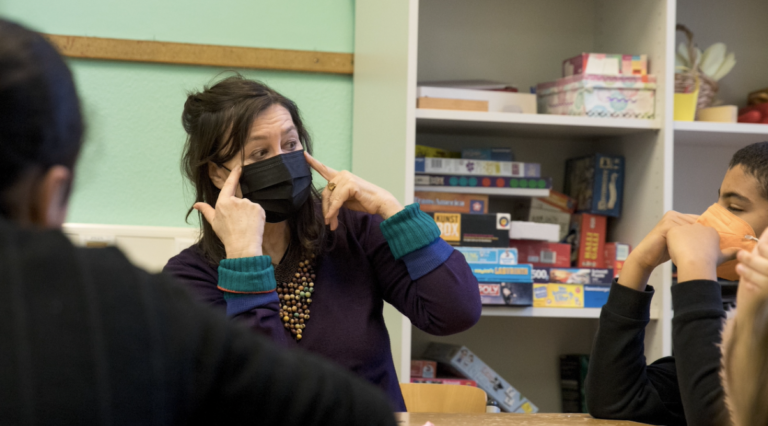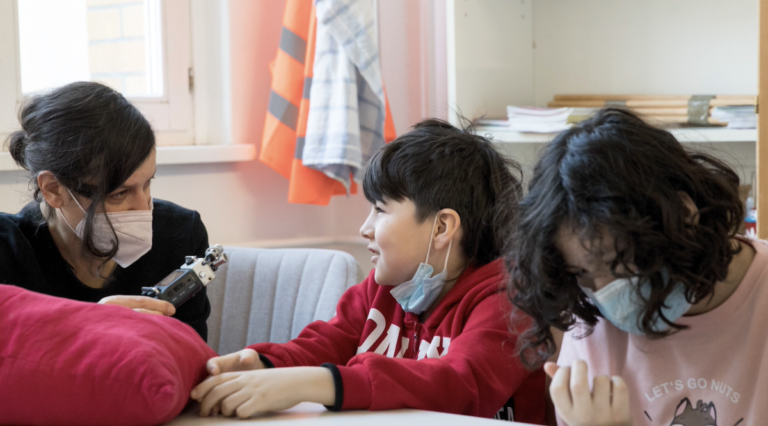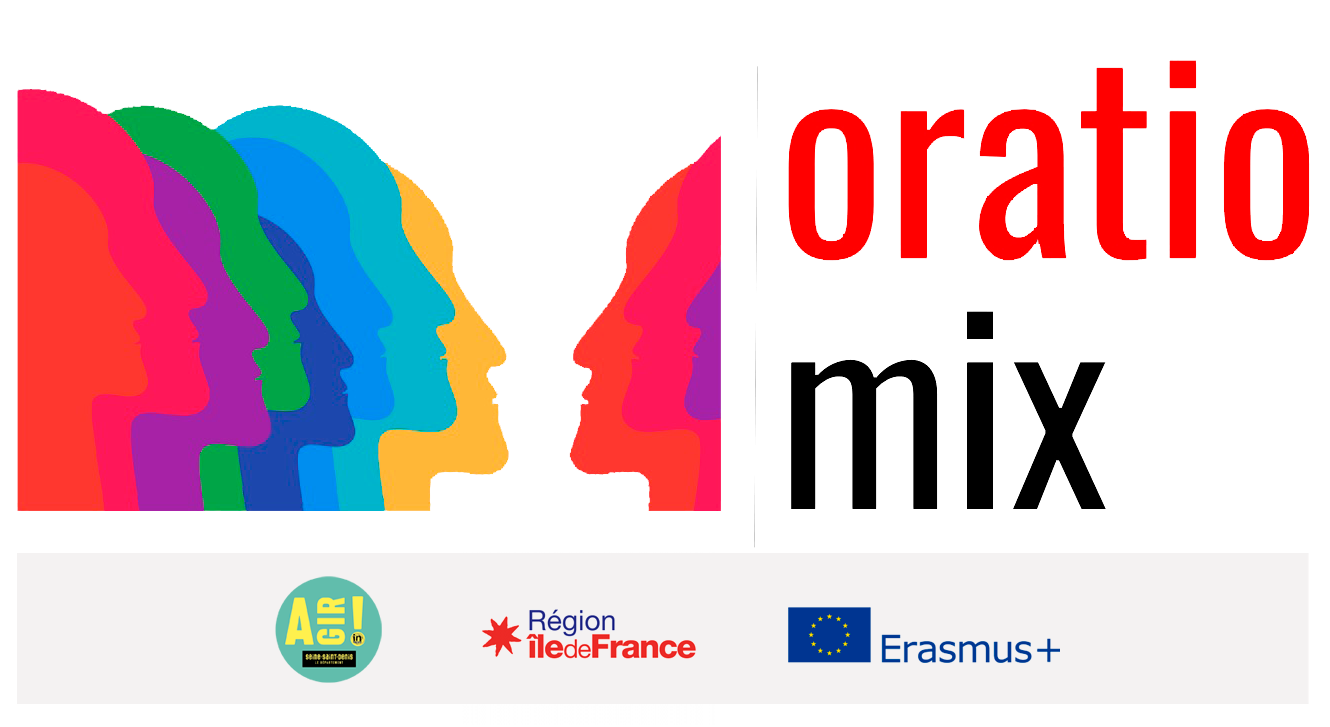Workshop 4
Implementation: what do we need?
– A workspace: the room provided must be large enough and arranged in such a way that it can accommodate all participants and allow freedom of movement, the workshop requiring physical commitment.
The participants
The methodology is aimed at primary and sixth grade students, aged between 9 and 13. Ideally, the group should not exceed 30 students.
Speaker
School teacher, educator, theatre teacher
Objectives of this workshop
Strengthen the capacity for individual and collective reflection around a text.
Reinforce the notions of listening, attention to others and debate.
Develop the ability to act as a group.
Time required
90-120 minutes
Implementation
The workshops use techniques of oral expression and debate around a theme related to a source text. They also put into practice, through body expression techniques, the questions theorized by students to allow a global understanding of the issues raised by the text.
Finality
At the end of the session, children will have:
Developed ability to work individually and in groups
Progressed towards acquiring communication skills
Strengthened their critical thinking by sharing and discussing symbolic themes present in their stories.
Students will improve their personal development and communication skills by practicing new body and speaking skills.
1. Start session
The clap
In a circle, the children pass a clap to their neighbor. e (one claps in his hands) while making the circle. For the clap to pass, students must look each other in the eye before clapping their hands!
2. Warm up
You can take the instructions seen last time (walk, stop, youpla, rhythms, numbers, environments) to see the evolution of students from one session to another.
Villagers/Vagabond.e.s: physical interpretation
First step: Walking in space:
Have students walk through space as a wanderer (give examples: they are cold, tired, hungry…). As they move, ask students to think about their physique, gestures and how they move as a character. Ask students to freeze in their wandering attitude.
Second step: Thoughts and feelings of vagabonds
The teacher. e freezes the action and taps each student’s shoulder asking them to reveal their inner thoughts and feelings as a character. Ask them to answer with “I feel…”. (This encourages participants to really think about the character or situation they describe. They are invited to use the expression of thoughts and feelings in relation to their body language and the position they have taken.) Discuss the body attitude of vagrants with students.
Third step: return to neutral
Get the students out of their (role-playing) roles Tell the students to get rid of the character, to “get out” of the character by saying “I am no longer the one. a vagabond. e, I am John” (“to clear” = to physically brush one arm with the other hand). Explain to the students that this “counting” helps us bring ourselves and ourselves back to reality. It can also get rid of all the negative feelings that accompany this character.
Fourth step: repeat the exercise with another character
Then, as before, have students walk through space as villagers. What is their body attitude, how do they move, etc? Discuss the physical appearance of the character. Freeze the action. Ask students in turn to reveal their inner thoughts and feelings as villagers by asking them to respond with “I feel…”. Get the students out of their roles, letting go of the character and saying “I am no longer the. a vagabond, I am John”.

3. The story
In groups, students imagine the rest of the story. Then, each group presents what they have prepared in front of the class. At the end of the presentations, the animator.ice proposes a debriefing time.
The group resumes reading the second part of the story.
Then the first wanderer shouted: Good people!
The villagers approached them. We are three hungry wanderers in a foreign country. We asked you for food and you have no food. In that case, we will have to prepare a soup with pebbles.
The villagers looked at each other. A soup with pebbles? We would be very curious to know what it is.
First, we will need a large iron pot, the vagabonds said. The villagers brought them the largest pot they could find. Otherwise, how to cook enough for everyone? It’s big enough! said the vagabonds.
And now we need water to fill it and a fire to heat it. It took a lot of buckets of water to fill the pot. A fire was lit in the village square and the pot was boiled.
And now, please, three round smooth pebbles. These were pretty easy to find. The eyes of the villagers widened when they saw the vagabonds throw the stones in the pot. Any soup needs salt and pepper, the vagabonds said, as they began to stir the pot. The children ran for salt and pepper.
These rocks usually make a good soup. But oh, if there were carrots, it would be even better. Oh, I think I have a carrot or two, said Françoise, and she ran away. She came back with an apron full of carrots that she had taken from the plants hidden under the old sheets.
A good pebble soup should contain cabbage, the wanderers said as they cut the carrots in the cauldron. But you don’t have to ask what you don’t have. I think I could find a cabbage somewhere, said Marie and she hurried home. And she came back with three cabbages from under the bed.
If only we had a little beef and a few potatoes, this soup would be worthy of a rich man’s table. The villagers thought about it. They remembered their potatoes and beef ribs hanging in the cellars. They ran to get them.
The soup of a rich man! And all from a few stones. It seemed magical! Ah, the wanderers sighed while mixing beef and potatoes, if only we had some barley and a cup of milk! The villagers exchanged glances. They brought their barley hidden in the granaries. They brought their milk from the bottom of the well. The vagabonds mixed the barley and milk with the steaming broth while the villagers watched. The soup was finally ready.
You will all taste our soup, the vagabonds said. But first, a table must be set. A large table has been placed in the square. And all around were lit torches. Such a soup! How good it smelled! Soon a banquet was organized and everyone sat down to eat. There had never been such a feast. The villagers had never tasted such a soup. And all this with stones! They ate and drank and ate and drank again. And after that, they danced. They danced and sang until late at night.
In the end, all were tired. Then the three wanderers asked: Is there an attic where we could sleep? Let three such wise and radiant people sleep in an attic? But no see! You must have the best beds in the village. So they went to bed and all the villagers and the 3 vagabonds slept well that night.
In the morning, the whole village gathered in the square to say goodbye to the vagabonds. Thank you very much for what you taught us, the villagers told the vagabonds. We will never be hungry, now that we know how to make soup with stones. Thank you for all your kindness, answered the vagabonds and they left on the road.

The facilitator proposes a time for discussion around the second part of the story. He asks students to compare and emphasize the differences and similarities between their ends of the story and the real story. How are they different/similar? Then, the facilitator provides a complementary discussion exploring students’ emotional vocabulary:
Basic needs: we all have your rights, no matter who we are and where we come from
The benefits of inclusion and the difficulties of exclusion
Working together versus individual needs
Community gathering
To be a. e good citizen and a human being of goodwill
By helping others, we help ourselves
The joy of the community and the celebration of teamwork.
What did we learn together? What does history teach us?
5. End of a ritual
Clapping
The. a leader stands opposite the other members of the group in order to be seen by all. He/she positions his arms horizontally and will clap his hands above his head. The others must imitate him at his/her pace. Then, little by little, he.elle will accelerate until reaching applause.
